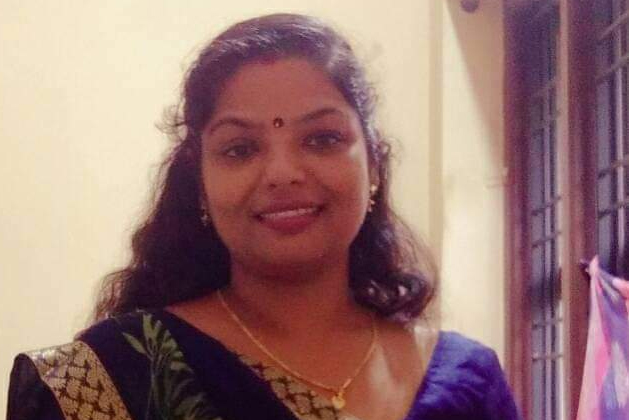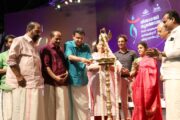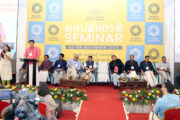Kerala Tourism: Strategies to be adopted post Covid-19

This is the fourth consecutive year that Kerala and the state tourism department have been faced with a massive disaster. Covid-19 or Novel Corona Virus as it is called, came to the state soon after the industry had entered a path of recovery path from a devastating cyclone like Ockhi, the Nipah outbreak and then the three consecutive floods. Even during such hard times, Kerala tourism could register 70% growth and occupied top position in any online-search for destinations anywhere in the world. According to Google Analytics of 2018 there has been 10,252,887 sessions/visits to the Kerala Tourism website.
Kerala was the first state to bear the brunt of Covid-19 in India, when a student from Wuhan, China tested positive. With three more cases, state government declared the epidemic as a “state calamity” which came as a bolt from the blue for the state tourism industry. This resulted in a negative feeling amongst both domestic as well as foreign tourists who questioned the safety aspect. Along with this, many countries came up with travel advisories against visiting Kerala, which affected footfalls. With the pandemic fast spreading in Middle East, Europe and Latin America, the remaining leisure travellers got wiped off during its peak season and thus the industry reached a new low. Yet, Kerala has come out largely unscathed. Today, the world is applauding and following the Kerala’s success model for containing the pandemic, whereas the most developed nations of the world have failed to address it adequately.
Kerala during Covid-19
Kerala showed the world that it has one of the best health care systems in the world. The availability of world-class doctors and nurses, who are in great demand even in Europe and America was a great boon. The state showed the rest of the world the relevance of Ayurveda, Homeopathy and Naturopathy for effectively containing the disease. Apart from that, the world understood the importance and relevance of ginger, garlic and turmeric in cuisines. As an icing on the cake, the state showed the importance of having a vigilant health minister, KK Shailaja, with whose timely intervention (screening of four international airports well in advance) we could curtail the spread of the pandemic. Breathing space was given to the population, bringing lockdown in a phased manner instead of an immediate shutdown. The whole society including guest labourers were provided with free rations and a safe place to live. Beggars and rag pickers who didn’t have their own house were provided with shelter, food and clothing by state government. The approach was basically less disruptive, less costly and very effective even with lack of support from central government. #Break the Chain concept became a mass movement and was adopted instantly by the state’s population. Decentralization to the grass root level by bringing in Kudumbashree units, local self-governments and panchayat for starting community kitchens and preparing nutritious food for Covid patients across the state just for Rs 20 were great measures.
Active cooperation across health, police, food and excise departments towards containing the virus was another positive feature. Celebrities came out, not only providing monetary help, but being physically present to help government to overcome the crisis. Religious institutions supported the government by conducting online prayers. A Rs 20,000 crore economic revival package was announced by the state government to overcome the crisis. A total of 33 hospitals including two Covid-exclusive hospitals were set up in each district. Use of route map through Geo Positioning System in order to identify primary and secondary contacts of Covid-19 infected patients and use of drones by police department were novel ideas bringing in technology to the forefront. Hence, the state left no stone unturned in trying to stop the spread of the virus.
Steps taken by Kerala Tourism
Kerala tourism can also boast of several achievements. The department issued strict guidelines to tourists and stakeholders three weeks ahead of the Ministry of Tourism. A separate web page was created for providing `Health advisory for Covid-19’ within the state’s tourism website. State tourism portal hyperlinked with Ministry of Tourism “Stranded in India Portal” for foreign tourists, showing its utmost care. Tourism stakeholders coordinated in order to take care of tourists. Their hospital treatment, stay at the hotel and return journey were coordinated by multiple agencies. An 83-year-old tourist Olive Leigh who successfully underwent Covid-19 treatment in Kochi, safely reached Italy. Follow up by doctors enquiring about the tourists’ well-being even after reaching their hometown was another way of showing that Kerala cares for its tourists. Government Medical Colleges were certified as the best by foreign tourists. “Kerala is safer than any other place and I will come back when everything becomes normal. Kerala is my second home,” were the words of Italian tourist Roberto Tonizzo, treated for Covid-19 at Government Medical College, Thriuvananthapuram. Tourism and Health departments worked hand in hand for the safe return of tourists. Arrangement of a state vehicle for the last Italian tourist Roberto Tonizzo to Bengaluru to ensure his safe travel back home, shows the ultimate hospitality and care by the state. On top of it the Minister of Tourism conducted webinars with tourism stakeholders and supported tourists to the hilt.
The state is still struggling with the disease and it is not clear when this pandemic will be over. Actually, with no rules in the book the right answers will constantly shift and industry cannot sit back by thinking about the past. With Covid-19, the consumption pattern of tourists will change drastically. The tourists would show some changes in their behaviour towards post pandemic travel. Some of the steps that could be taken by stakeholders to promote Kerala tourism would be:
1. Getting strategic
- Increase market research to find out which segments would recover first.
- Identify the new market segments of interest to the tourists.
- Create valid vouchers and coupons in order to have sustainable tourism.
- Write stories about people who do great things in your community and publish online.
2. Financial goals
- Secure additional funding resources through cooperative societies.
- Short term cash flow mechanisms that allow minimum cash flows.
3. Marketing
- Restrict all marketing activities such as advertising, when the tourists are unwilling to travel.
- Throughout the world enthusiastic young travellers are waiting for the crisis to be over. So this segment should be harnessed in order to increase revenue of state tourism.
- Restructure advertising budgets, focus more on domestic and nearby markets.
4. Aim for local markets
- Create gaming cards in order to motivate local residents to take photographs in front of any local landmarks by social distancing as done by Auburn-Opelika Tourism.
- Go for e-shops to support shopping and restaurants in Kerala, as done by Antwerp tourism.
- Ask tourists to give positive reviews of local businesses they had visited once and encourage them to shop online. This could be posted on the state website.
- Once everything becomes normal insist on getting out there and shop local.
5. Promote staycations
- A dedicated website which promotes local activities of destinations that are not currently in lockdown could be promoted.
- Locals should be encouraged to enjoy nearby destinations.
- These destinations could be used for future travellers once the lockdown is removed.
- This could encourage local residents as well.
6. Going Digital
- Social networking with Facebook, Instagram focusing on “good news stories” that the state has achieved during Covid-19.
- Positive video messages by international tourists should be constantly streamlined in the Kerala tourism website like messages of Italian tourists and the like.
- Messages on how safe the destination is, could be added on Kerala Tourism’s Covid-19 webpage along with other policies.
- Videos supporting health-workers could be streamlined on the website.
- Positive messages motivating people to travel again could be like “We are open for business” or “Tourists are welcome here” or “We will Travel” as done by Marriott will have positive impact on tourists.
- A number of online resources could be created like 3D video on yoga classes which will be quite entertaining and interesting for tourists.
- Kerala can feature its stunning landscape, designed for potential tourists to give a “small moments of escape” as done by Canadian tourism promoting “Glowing Hearts Campaign”
- Provide visitors to have a chance of visiting tourist destinations virtually from the comfort of the home as done by Austria tourism’s #Austrianhomestories and Vienna tourist board.
- A dedicated web page highlighting the safety measures, hotline numbers, changes in policy will allow the website to score more highly with Google search for those keywords.
- Content creation in the form of blogs, vlogs etc that tap the dreams of tourists will help in future bookings.
- Business owners could use social media like Weibo, WeChat, Tik-Tok to promote its products, via broadcast, podcast and online interaction.
- Use of Cinemagraph in the website can create memorable, impactful visuals, real thumb-stopping content, which the followers are sure to engage and share.
7. Staffing
- Do not make them go for compulsory leave until they want to leave the organisation.
- Release temporary staff first and then permanent if the crisis does not end.
- Reassure the staff as they are essential stakeholders.
- Promote teleconferencing and video conferencing facilities and stay connected.
- As an emergency, replace highly paid employees with low paid fresh employees
- Try for out-sourcing as a cost-effective measure
- Now is the ideal time to up-skill your employees through digital platforms using webinars, e-learning, social media campaigns and the like.
8. Operational features
- Try to facilitate re-bookings in order to avoid cancellations.
- Reduce services to minimum like going in for home delivery.
- Schemes like “Corona Voucher” with one-year validity that can be used for reimbursing the money back, with an option to avail an attractive trip.
- Keep your action plan ready if any tourists fall ill.
- Improve the hygiene and sanitation work.
- Change from buffet food to plated food.
- Reliable information on a daily basis should be provided utilizing data resources.
9. Local Community
- Develop a public relations network with local people, enumerate the benefits of tourism and remind them to welcome tourists when the time is right.
- Work closely with health workers to contain the disease.
- Time could be utilized for offering free training to local people and tourism students through webinars to update their skills which could also include English or any other foreign language proficiency.
- Promote close cooperation with non-industry stakeholders like NGOs.
10. New “Normal”
- Everything is going to change after Covid-19, so evaluate earlier decisions and make changes accordingly.
- “Virtual experiences” are allowing people to visit destinations virtually. This has been implemented in New York wherein Google Arts and Culture has teamed up with museums, exhibitions and galleries. People can easily walk through New York’s Guggenheim Museum in this fashion.
- Options like live streaming using cameras could help visitors to visit a zoo or a destination of his or her choice sitting at home.
- Ability to create an illusion of a destination would be a new offering that can encourage future visits.
- Restaurants may go in for personal serving spoons, contactless delivery promoting in-room-dining and designing menus in single portions rather than shared ones.
- More use of robots with Artificial Intelligence who will not only take the orders but also serve the customers.
- Traveller expectations of hygiene will be higher.
- More use of contactless services, like online check-in, payment and the like, thus increasing new norms towards privacy measures.
- There will be a very high chance that tourists will avoid overcrowding and may prepare for isolated and off-the-beaten path experiences.
- Shifting focus to local market and national or regional tourism will be the new norm.
- Tourists will expect more care for tourists with relaxed refund and cancellation policies.
- Travellers will look for more travel advisors who provide better service and security.
- Destinations will have to create offerings that guarantees combination of wellness, safety and benefits.
This is a temporary phase and the world will get over it. It’s important to be calm with measured leadership. It should be understood that with travel ban, everyone has resorted to social media and websites for information and guidance. These channels have become relevant to overcome crisis. Health and safety of tourists are the top priorities now along with timely information regarding the current situation about the destination. Ultimately, one has to continuously observe the situation that is unfolding in front of us, be proactive and help one another to overcome this crisis. Remember what India Today’s Rajdeep Sardesai said, “What Kerala thinks today, India thinks tomorrow”.
(Author is Dr. Sindhu R. Babu, Asst. Professor of Tourism, School of Tourism Studies, M G University, Kottayam)






